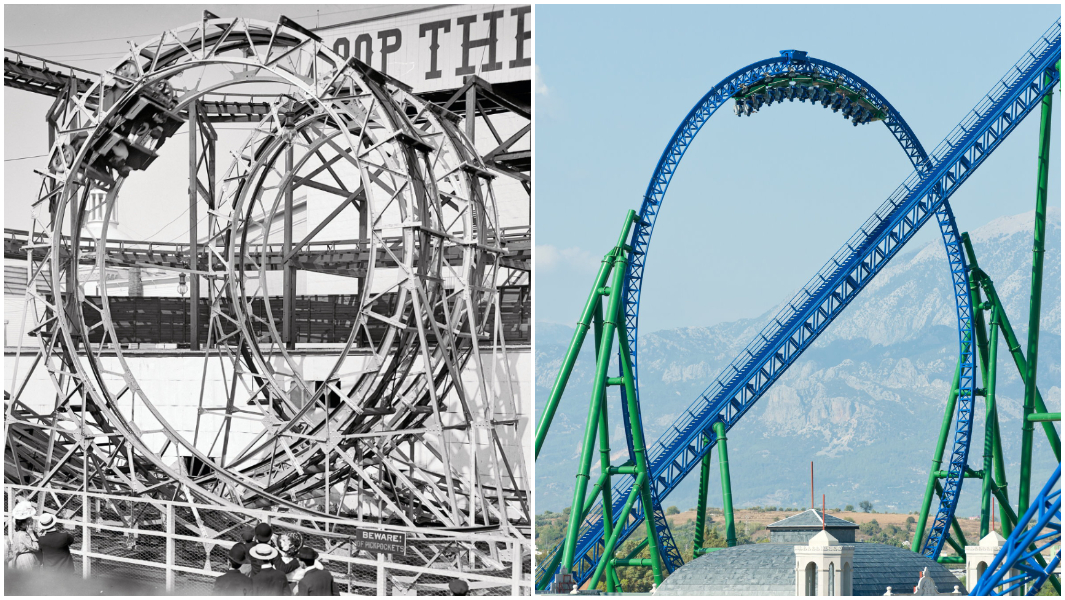First looping rollercoaster was a spectacle to attract the curious and scientific

A key attraction at most theme parks are the rollercoasters, with the looping variety being the ultimate rides for thrill seekers.
But have you ever stopped to think about where they originated from?
The first looping rollercoaster was called a centrifugal railway.

It differed from the first rollercoaster, which was Nicholas Beaujon's Promenades Aériennes, located on the Champs-Élysées in Paris, France, because of its loop.
Although France and New York are often credited for inventing the first centrifugal railway, the earliest full-size example was actually built by the Manchester, UK-based engineering firm Tarr & Riley in the spring of 1842.
It was exhibited at the Manchester Hall of Science in March of that year before being moved to Liverpool’s Royal Liver Theatre by mid-April.
According to book 2,000 Years of Manchester, the rollercoaster was not intended to be a fun ride, but rather a spectacle to attract the “curious and scientific.”
The entrance fee was 6 pence during the day (with reserved seats for ladies) and 3 pence in the evening.
The contraption measured over 200 feet long and was considered enormous for its time.
According to an advertisement, it could safely carry “living men,” heavy weight, and a bucket of water without spilling a drop.
It featured a 40-foot vertical circle at a speed of almost 100 mph (160.9 km).
Before it was allowed to carry people, the machine had been tested with sandbags and a monkey.
The rollercoaster, which was described as “one of the greatest wonders of the age,” was then moved to Liverpool, Belfast, and other cities throughout the United Kingdom.
The centrifugal railway gave way to the first permanently installed one, and the first to be routinely used as a ride.
It was erected at Liverpool Zoological Gardens in May 1843.
Centrifugal railways then began to spring up throughout Western Europe in the middle of the 19th century.

The size of each centrifugal railway differed, but some were said to have vertical loops of 6.5 feet (2 m), while others were estimated to have 40-foot (12-m) loops.
Installations were eventually placed in the French cities of Bordeaux, Le Havre, and Lyons.
Centrifugal railways were significantly tested before allowing people to ride on them.
There aren’t many first-hand accounts from riders of what it was like to ride a centrifugal railway.
Rider operators and promoters were said to grossly exaggerate how fast and how large the rides actually were, even claiming that some could reach a speed of more than 150 miles (241.4 km) per hour.
Although the centrifugal railways didn’t have any reported safety issues, one built in 1865 at the Cirque Napoleon in Paris was eventually closed by police after the very first car making its way through the loop derailed.
The rides proved to be unpopular and additional looping roller coasters were not built for almost 20 years.
The circular loops used in centrifugal railways differed from the tear-shaped loops used in modern-day rollercoasters, which produce lower g-forces and less discomfort for the riders.
Today, rollercoasters are much safer.
Rollercoaster engineers have changed the loop’s design over time, introducing the clothoid loop.
Looping rollercoasters require greater entry speeds to complete the entire loop.
The greater entry speeds expose riders to greater centripetal acceleration through the bottom half of the loop.
If the radius is decreased at the top of the loop, the centripetal acceleration is increased enough to keep the passengers and the train from slowing down excessively and derailing.

Today, the fastest rollercoaster in the world is the Formula Rossa at Ferrari World in Abu Dhabi, UAE.
Although it doesn’t have any loops, it can accelerate up to 240 km/h (149.1 mph) and 52 m upwards in 4.9 seconds.
Read more about the first looping rollercoaster in Guinness World Records 2024, out now!
Want more? Follow us on Google News and across our social media channels to stay up-to-date with all things Guinness World Records! You can find us on Facebook, Twitter/X, Instagram, Threads, TikTok, LinkedIn, and Snapchat Discover.
Don't forget to check out our videos on YouTube and become part of our group chat by following the Guinness World Records WhatsApp channel.
Still not had enough? Click here to buy our latest book, filled to the brim with stories about our amazing record breakers.


